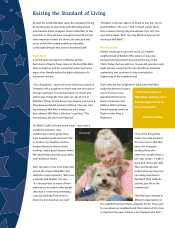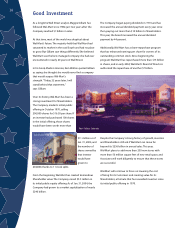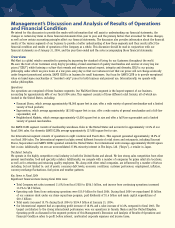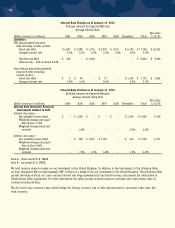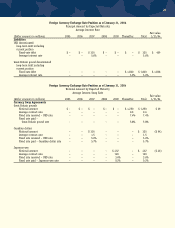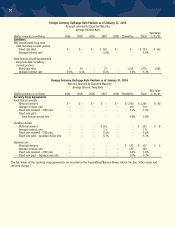Walmart 2004 Annual Report Download - page 22
Download and view the complete annual report
Please find page 22 of the 2004 Walmart annual report below. You can navigate through the pages in the report by either clicking on the pages listed below, or by using the keyword search tool below to find specific information within the annual report.
addition of 139 new Discount Stores, Supercenters and Neighborhood Markets, as well as 130 conversions and/or relocations from
Discount Stores to Supercenters. One domestic Discount Store was closed during fiscal 2004. Additionally, we opened 13 SAM’S CLUBs
domestically in fiscal 2004. Properties vacated as the result of relocation to a new site within the same trade area are not considered
closings. Internationally, we added 83 units net of closings. Worldwide, square footage increased approximately 46 million square feet,
or 8%, during fiscal 2004.
The Wal-Mart Stores segment net sales amounted to approximately 68% of total Company net sales in fiscal 2004, which compares to
68.4% in fiscal 2003 and 68.2% in fiscal 2002. The SAM’S CLUB segment net sales amounted to approximately 13.5% of total Company
net sales in fiscal 2004, which compares to 13.8% and 14.4% in fiscal 2003 and 2002, respectively. International sales accounted for
approximately 18.5% of total Company net sales in fiscal 2004 compared with 17.8% in fiscal 2003 and 17.4% in fiscal 2002. The
Wal-Mart Stores segment’s net sales decline as a percentage of total Company net sales from fiscal 2003 to 2004 is largely the result of
the favorable impact of foreign exchange on International Segment sales in fiscal 2004. The decrease in the SAM’S CLUB segment’s sales
as a percent of total Company sales in fiscal 2004 and 2003 when compared to fiscal 2002 resulted from the more rapid development of
new stores in the International segment and the Wal-Mart Stores segment than the SAM’S CLUB segment, as well as the favorable
impact of foreign exchange on International segment sales in fiscal 2004.
As we continue to add new stores domestically, we do so with an understanding that additional stores may take sales away from
existing units. We estimate that comparative store sales in fiscal 2004, 2003 and 2002 were negatively impacted by the opening of new
stores by approximately 1%. We expect that this effect of opening new stores on comparable store sales will continue during fiscal 2005
at a similar rate.
The net sales increase of 13% in fiscal 2003, when compared with fiscal 2002, resulted from our domestic and international expansion
programs, along with comparative store sales increases. Domestic expansion during fiscal 2003 resulted from the addition of 131 new
Discount Stores, Supercenters and Neighborhood Markets, as well as 122 conversions and/or relocations from Discount Stores to
Supercenters. Additionally, we opened 25 SAM’S CLUBs in fiscal 2003. No domestic locations were closed during fiscal 2003.
Internationally, we added 118 units net of closings. Worldwide, square footage increased approximately 45 million square feet, or 9%,
during fiscal 2003.
Costs and Expenses
For fiscal 2004, our cost of sales decreased as a percentage of total net sales when compared to fiscal 2003, resulting in an overall
increase of 0.2% in the Company’s gross profit as a percentage of sales (our “gross margin”) from 22.3% in fiscal 2003 to a gross margin
of 22.5% in fiscal 2004. This increase in gross margin occurred primarily due to a favorable shift in mix of products sold and our global
sourcing efforts (which resulted in lower cost for merchandise sold), offset by increased apparel markdowns (price reductions) in the
second half of the year.
Due to the Company’s program to convert many of our Discount Stores to Supercenters, which have full-line supermarkets, and the
opening of additional Supercenters and Neighborhood Markets, we expect that food sales will increase as a percentage of our total net
sales. Because food items generally carry a lower gross margin than our other merchandise, increasing food sales tends to have an
unfavorable impact on our total gross margin. However, we feel that we can more than compensate for the effect on gross margin by
increased food sales in the near term through reduced markdowns compared to fiscal 2004 and in the foreseeable future by continuing
to leverage our global sourcing programs and continuing to challenge our internal and external cost structures.
Our total cost of sales as a percentage of our total net sales decreased for fiscal 2003 when compared to fiscal 2002, resulting in an
increase in gross margin of 0.3% from 22.0% for fiscal 2002 to 22.3% in fiscal 2003. This increase in gross margin resulted primarily due
to lower shrinkage (reduction of inventory due to theft or loss), reduced markdowns and a favorable shift in the mix of products sold.
Our operating, selling, general and administrative expenses (“SG&A expenses”) increased 0.1% as a percentage of total net sales to
17.5% in fiscal 2004 when compared with 17.4% in fiscal 2003. Most of this increase resulted from an increase in insurance costs,
including medical, property and casualty insurance, which increased 0.1% as a percentage of sales in fiscal 2004 compared with fiscal
2003. Management believes that the trend of increasing insurance costs will continue for at least the near future. The remainder of the
increase is primarily attributable to the adoption of the Emerging Issues Task Force Issue No. 02-16, “Accounting by a Reseller for Cash
Consideration Received from a Vendor” (“EITF 02-16”) in fiscal 2004. Under EITF 02-16, advertising support received from suppliers
that was historically accounted for as a reduction of advertising expense has been accounted for in the current year as a reduction of
purchases. The adoption of EITF 02-16 resulted in an after-tax reduction in net income of approximately $140 million, or $0.03 per share.
Our SG&A expenses increased 0.2% as a percentage of total net sales to 17.4% in fiscal 2003 when compared with 17.2% in fiscal 2002.
A substantial portion of that increase was attributable to increased insurance costs, including medical, property and casualty insurance,
which increased by 0.1% as a percentage of our total net sales in fiscal 2003 compared to fiscal 2002. The remainder of the increase was
primarily attributable to payroll and payroll-related costs.
20




